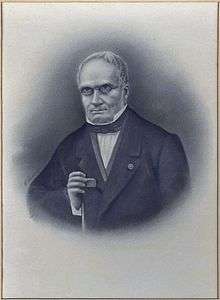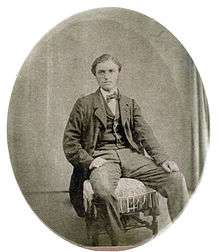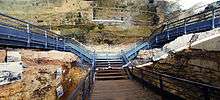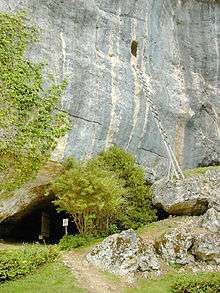Les Eyzies-de-Tayac-Sireuil
Les Eyzies-de-Tayac-Sireuil (Occitan: Las Aisiás de Taiac e Siruèlh) is a former commune in the Dordogne department in Nouvelle-Aquitaine in southwestern France. On 1 January 2019, it was merged into the new commune Les Eyzies.[2]
Les Eyzies-de-Tayac-Sireuil | |
|---|---|
Part of Les Eyzies | |
 | |
Location of Les Eyzies-de-Tayac-Sireuil 
| |
 Les Eyzies-de-Tayac-Sireuil  Les Eyzies-de-Tayac-Sireuil | |
| Coordinates: 44°56′10″N 1°01′05″E | |
| Country | France |
| Region | Nouvelle-Aquitaine |
| Department | Dordogne |
| Arrondissement | Sarlat-la-Canéda |
| Canton | Vallée de l'Homme |
| Commune | Les Eyzies |
| Area 1 | 37.44 km2 (14.46 sq mi) |
| Population (2017-01-01)[1] | 834 |
| • Density | 22/km2 (58/sq mi) |
| Time zone | UTC+01:00 (CET) |
| • Summer (DST) | UTC+02:00 (CEST) |
| Postal code | 24620 |
| Elevation | 55–245 m (180–804 ft) (avg. 74 m or 243 ft) |
| 1 French Land Register data, which excludes lakes, ponds, glaciers > 1 km2 (0.386 sq mi or 247 acres) and river estuaries. | |
Les Eyzies-de-Tayac-Sireuil lies in the Périgord Noir area. It is served by the Gare des Eyzies railway station. This locale is home to the Musée national de Préhistoire (National Museum of Prehistory) and the area contains several important archaeological sites, including the Font-de-Gaume, Grotte du Grand-Roc and Lascaux cave prehistoric rock dwellings. Les Eyzies-de-Tayac was designated a UNESCO World Heritage site in 1979.
Geography
Location

The commune is located at the confluence of the Vézère and the Beune rivers. It is accessible by the SNCF network at the Gare des Eyzies, by the A89 motorway, exit 16 Périgueux-East (Bordeaux – Périgueux axis) and then by the D710 road or by Montignac via Terrasson (Lyon - Terrasson-Lavilledieu axis). In the north-west, the commune is also watered by another small tributary of the Vézère, the Manaurie.
Climate
In the Dordogne department, the highest temperature was recorded on 4 and 5 August 2003 at Les Eyzies-de-Tayac-Sireuil, with 43°C.
Neighbouring communes and villages
Population
| Historical population | ||
|---|---|---|
| Year | Pop. | ±% |
| 1962 | 1,091 | — |
| 1968 | 1,004 | −8.0% |
| 1975 | 886 | −11.8% |
| 1982 | 858 | −3.2% |
| 1990 | 853 | −0.6% |
| 1999 | 909 | +6.6% |
| 2008 | 835 | −8.1% |
Toponymy
In Occitan, the commune bears the name Las Aisiás de Taiac e Siruèlh.
History
In March 1868, the geologist Louis Lartet, financed by Henry Christy, discovered the first five skeletons of Cro-Magnons, the earliest known examples of Homo sapiens sapiens, in the Cro-Magnon rock shelter at Les Eyzies-de-Tayac. These skeletons included a foetus, and the skulls found were remarkably modern-looking and much rounder than the earlier Neanderthal.
Economy
As at 31 December 2013, the municipality has 209 establishments, including 151 in the field of commerce, transport or services, twenty relating to the administrative sector, education, health or social action, eighteen in construction, thirteen in the industry, and seven in agriculture, forestry or fishing.
Places and monuments

- L'Homme primitif is a statue of Paul Dardé, inaugurated in 1931 and placed on a natural platform that dominates the village of Les Eyzies; It can be approached during the visit of the National Museum of Prehistory.
Natural Sites
- Grotte du Grand Roc, cave with natural eccentric crystallisations comparable to corals.
Prehistoric sites
The municipality has many prehistoric archaeological sites including:
- The Grotte de Font-de-Gaume, the last cave with prehistoric polychrome paintings still open to visit in the region
- Les Combarelles - 600 pre-historic engravings of animals and symbols
- Grotte de la Mouthe - ornate cave of the Upper Paleolithic period
- La Grotte de Bernifal
- The deposit of La Micoque - discovery of numerous testimonies of the lithic industries of the Paleolithic (Tayacian, Micoquien and Mousterian)
- Abri Chadourne, named after its owner
- L'abri Audi|
- L'abri de Cro-Magnon, the eponymous site of the Cro-Magnon man.
- L'abri Pataud, a site studied under the responsibility of the National Museum of Natural History. The stratigraphic sequences comprises Upper Paleolithic levels, in particular, from bottom to top, Aurignacian, Gravettian, and Protomagdalénien
- Laugerie-Basse and Laugerie-Haute - paleolithic sites
- L'abri du Poisson - carved in low relief at the ceiling of the vault, raised in red colour a salmon
- Le vallon de Gorges d'enfer (private site closed)
- Les grottes du Roc de Cazelle constitute a troglodytic site occupied from prehistoric times until 1960.
Many of these sites have been classified as World Heritage sites by UNESCO as Sites préhistoriques et grottes ornées de la vallée de la Vézère. The discovery of these shelters within a restricted radius around Les Eyzies, their methodical exploration and the study of the deposits they concealed allowed prehistory to build up as a science and explains why the city claims the status of world capital of the prehistory, as the publicity leaflets recall.
Museum
The National Museum of Prehistory, where many prehistoric discoveries are preserved, is located in the heart of the village. Very rich in carved flints, it is especially aimed at specialists.
Historical Sites
- Château de Commarque, 12th century, 14th century, 15th century, classified.
- Château de Tayac and its dependencies, 12th century 14th century 15th century.
Personalities related to the municipality
- Cro-Magnon Man
The Pioneers of Archaeology:
- Louis and Édouard Lartet
- Denis Peyrony
- Élie Peyrony
- Henri Breuil
- Louis Capitan
 Édouard Lartet
Édouard Lartet Louis Lartet
Louis Lartet Henri Breuil
Henri Breuil
Galerie
.jpg)
National Museum of Prehistory 

Grotte de Font-de-Gaume 
Abri de Cro-Magnon 
La Micoque 
Le plateau qui domine
Les Eyzies
L'église-forteresse de Tayac 
Grotte du Grand Roc 
Mammouth gravé de la grotte des Combarelles 
Entrée de la grotte de Bernifal
See also
References
- "Populations légales 2017". INSEE. Retrieved 6 January 2020.
- Arrêté préfectoral 11 October 2018, p. 73 (in French)
External links
| Wikimedia Commons has media related to Les Eyzies-de-Tayac-Sireuil. |